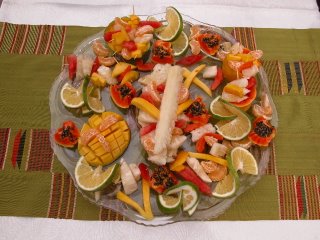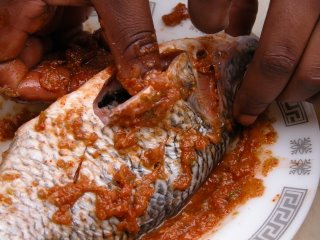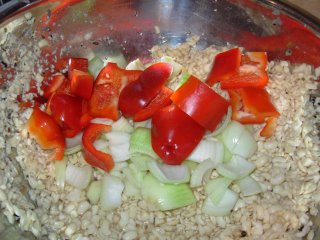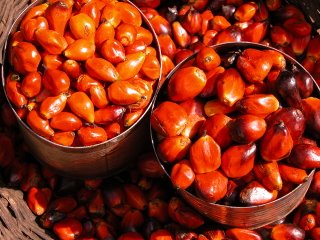Recipe #8: Bissap, Hibiscus Iced Tea
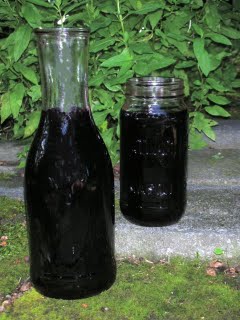 It's summertime, the season of requests for bissap or bissap rouge. This is a refreshing iced tea popular in Ghana and other parts of West Africa. It is made from dried hibiscus flowers. I pictured a mango-bissap version in a blog last year. It is easy to make and the smooth, sweet-tangy combination tends to draw rave reviews. While I'm waiting for my cornmeal dough to ferment to make the banku (recipe #7), here's recipe #8. As I've said elsewhere, the dried hibiscus flowers pair well with other flavorings, from pineapple to mango juices. This recipe is the one I first learned in Ghana, and still make most often, but feel free to experiment with other flavorings.
It's summertime, the season of requests for bissap or bissap rouge. This is a refreshing iced tea popular in Ghana and other parts of West Africa. It is made from dried hibiscus flowers. I pictured a mango-bissap version in a blog last year. It is easy to make and the smooth, sweet-tangy combination tends to draw rave reviews. While I'm waiting for my cornmeal dough to ferment to make the banku (recipe #7), here's recipe #8. As I've said elsewhere, the dried hibiscus flowers pair well with other flavorings, from pineapple to mango juices. This recipe is the one I first learned in Ghana, and still make most often, but feel free to experiment with other flavorings.I can usually find dried hibiscus flowers in international stores that stock Mediterranean goods, or African stores carrying North African (especially Egyptian) foods or West African ingredients. Since a Christmas version is popular in Jamaica, perhaps a Caribbean market would also be a good place to look. Lots of herbal teas contain dried hibiscus flowers, so a health foods store or tea shop might be another place to locate them.
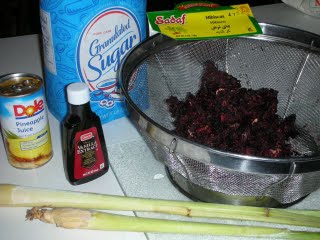 Fresh lemon grass is available in Asian markets where it's inexpensive, or your local grocery store where it may be less fresh and/or pricey. Also, I always use real, not imitation, vanilla flavoring.
Fresh lemon grass is available in Asian markets where it's inexpensive, or your local grocery store where it may be less fresh and/or pricey. Also, I always use real, not imitation, vanilla flavoring.Ingredients:
2 cups dried hibiscus flowers (bissap or roselle)
1/4 cup fresh lemon grass, chopped (optional)
1/2 teaspoon vanilla or rum flavoring (or to taste)
sugar to taste (probably 1 to 2 cups; or sugar substitute)
5 cups of boiling water
1 cup of juice (optional, I'm using pineapple today)
You can mix and match flavorings according to your taste: e.g., 1/2 cup lemon juice, OR a cup of mango OR pineapple OR orange juice, OR mint sprigs OR a little fresh grated ginger. I have some pineapple juice handy, so I'm going with lemon grass, vanilla, and pineapple juice.
Bring the water to a boil. While it's heating, I generally put the 2 cups of hibiscus flowers in a metal strainer in the sink and rinse them lightly with water to remove any sand or grit they might contain (the dried flowers bleed immediately, so make sure you keep the strainer in the sink). Then I pull off the outside leaves of the lemon grass, rinse and chop it.
Put the rinsed flowers and the lemon grass into a large stainless steel or ceramic bowl, and pour the boiling water over all. I cover the bowl with a cheese cloth to protect it and let it sit for at least 4 hours. Then bring another 5 cups of water (*see note below on reducing this amount of water and adding sparkling water when serving) to a boil. Place a strainer over a second large bowl and empty the liquid from the hibiscus/lemongrass mixture into it. Return the hibiscus/lemon grass to the original bowl and pour the just-boiled water over them. Stir the mixture well, and let it sit a few minutes, and pour it through the strainer again to add to the previously strained liquid, pushing down on the strainer with a spoon to remove as much of the water as possible (Actually, I use the cheesecloth I covered the bowl with to line the strainer before adding the hibiscus and lemon grass mixture the second time, and after pouring the boiling water through, twist it tightly to remove as much liquid as possible. In Ghana we don't waste a drop.) Discard the hibiscus flowers and lemon grass.
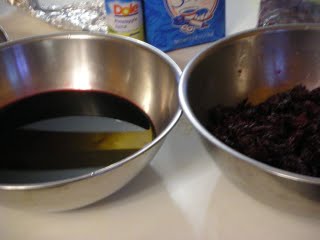
Now stir in the sugar to taste and your desired flavorings. Today, that's vanilla and pineapple. After all of the sugar has dissolved, carefully pour off the liquid into a pitcher or jar, making sure to leave any sediment behind in the bowl. Store the bissap, covered, in the refrigerator and chill. When serving, pour into a glass and add ice and/or water as desired. If you use a cheesecloth to line the strainer the second time you pour the water through the flowers, make sure to soak and rinse it well in cold water right away to keep from staining it.
*Sometimes I use less boiling water the second time (only 2 or 3 cups), and add chilled sparkling water when serving the bissap. Enjoy! But be forewarned: bissap is addictive.
Garnish: use fresh mint leaves, fruit slices, or a sugar cane swizzle stick.
Tomorrow: the corn dough is fermented now, so I'll finish the banku recipe.
Labels: African iced tea, bissap, hibiscus
